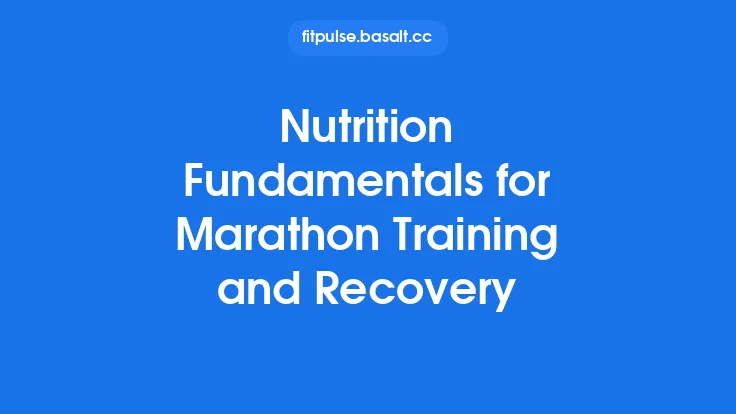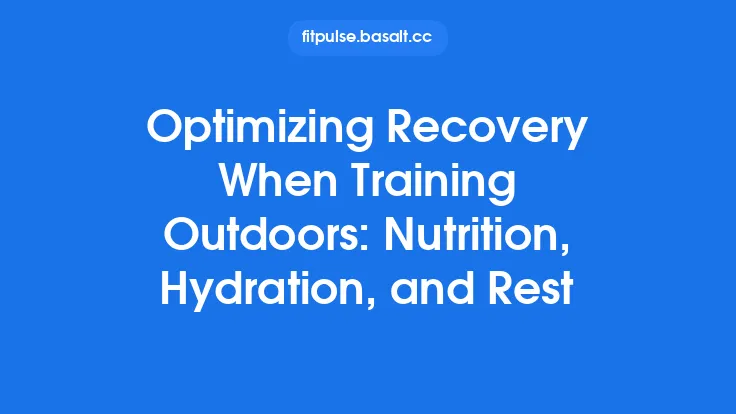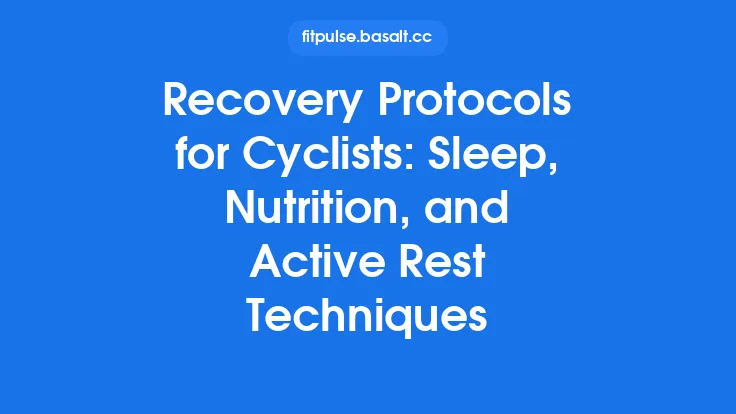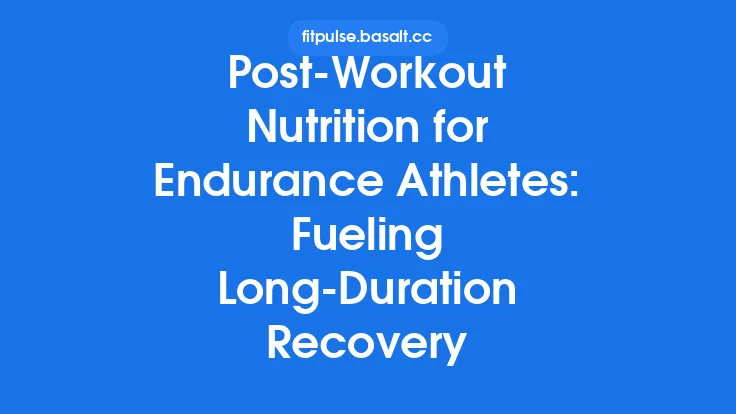Swimming is a demanding sport that taxes the cardiovascular system, muscles, and nervous system simultaneously. Because every kick, pull, and breath requires energy, the food and fluids a swimmer consumes can be the difference between a personal best and a frustrating plateau. This article explores the science behind fueling the swimmer’s body, outlines practical strategies for everyday training, and provides evidence‑based guidance for optimizing recovery after hard sessions or competitions. Whether you’re a high‑school athlete, a collegiate scholar, or an elite distance swimmer, the principles below can be adapted to fit any training load, schedule, and personal preference.
Understanding Energy Demands in the Pool
Aerobic vs. Anaerobic Contributions
Swim workouts typically blend long, steady‑state aerobic sets (e.g., 1500‑m freestyle at a moderate pace) with short, high‑intensity intervals (e.g., 25‑m sprints with 30‑second rest). Aerobic work relies primarily on carbohydrate and fat oxidation, while anaerobic bursts depend heavily on stored muscle glycogen and phosphocreatine. The proportion of each energy system used varies with distance, intensity, and the swimmer’s conditioning level.
Caloric Expenditure
A 70‑kg (154‑lb) swimmer can burn anywhere from 600 to 1,200 kcal per hour during vigorous training, depending on water temperature, stroke efficiency, and effort. Open‑water sessions in colder water increase basal metabolic rate because the body must generate extra heat. Understanding these numbers helps athletes estimate how much fuel they need to replace each day.
The Role of Water Temperature
Cold water (≤ 20 °C / 68 °F) raises energy cost due to thermogenesis, while warm water (≥ 28 °C / 82 °F) can limit sweat loss but increase perceived exertion. Adjusting caloric intake and fluid strategy according to pool temperature is an often‑overlooked nuance that can improve performance and comfort.
Macronutrient Foundations
Carbohydrates: The Primary Fuel
- Why they matter: Carbohydrates are the most efficient source of ATP during high‑intensity swimming. Glycogen stores in muscle and liver provide the rapid energy needed for sprints and interval sets.
- Daily intake: 5–7 g · kg⁻¹ for moderate training; 7–10 g · kg⁻¹ for heavy volume or race‑specific preparation.
- Timing:
- Pre‑session (1–4 h): 1–2 g · kg⁻¹ of low‑glycemic carbs (e.g., oatmeal, whole‑grain toast) to top off glycogen without causing gastrointestinal distress.
- During long sessions (> 90 min): 30–60 g of easily digestible carbs per hour (sports drinks, gels, banana) to maintain blood glucose.
- Post‑session (within 30 min): 1–1.2 g · kg⁻¹ of high‑glycemic carbs (e.g., fruit juice, rice) to replenish glycogen rapidly.
Protein: Repair and Adaptation
- Why it matters: Swimming stresses both upper‑body pulling muscles and lower‑body kicking muscles. Protein provides the amino acids needed for muscle protein synthesis (MPS) and recovery.
- Daily intake: 1.4–2.0 g · kg⁻¹ for most swimmers; up to 2.2 g · kg⁻¹ for those in heavy strength phases.
- Distribution: Aim for 20–30 g of high‑quality protein (≥ 8 g of essential amino acids) every 3–4 h, including a serving within the post‑exercise “anabolic window.” Sources include lean poultry, fish, dairy, eggs, soy, and whey isolates.
Fats: Endurance and Hormonal Health
- Why they matter: Fat oxidation dominates during low‑intensity, long‑duration swims and supports overall caloric density. Essential fatty acids (omega‑3) also aid inflammation control.
- Daily intake: 20–35 % of total calories, with at least 0.5 g · kg⁻¹ of combined omega‑3 EPA/DHA for athletes engaged in high training loads.
- Practical tips: Incorporate nuts, seeds, avocado, olive oil, and fatty fish. Avoid heavy, high‑fat meals immediately before training, as they can delay gastric emptying.
Micronutrient Considerations
| Nutrient | Primary Role for Swimmers | Food Sources | Typical Recommendation |
|---|---|---|---|
| Sodium | Maintains fluid balance, prevents hyponatremia during long sessions | Salted nuts, pretzels, sports drinks | 500–1,200 mg · h⁻¹ during > 2 h workouts |
| Potassium | Supports muscle contraction and nerve transmission | Bananas, potatoes, leafy greens | 4,700 mg/day (general adult) |
| Calcium | Bone health, muscle signaling | Dairy, fortified plant milks, kale | 1,000–1,300 mg/day |
| Vitamin D | Immune function, bone remodeling | Sun exposure, fatty fish, fortified foods | 600–1,000 IU/day (adjust for deficiency) |
| Iron | Oxygen transport; critical for endurance | Red meat, lentils, spinach (with vitamin C) | 8–18 mg/day (higher for females) |
| Magnesium | Energy production, electrolyte balance | Nuts, seeds, whole grains | 310–420 mg/day |
Regular blood work (especially for iron, vitamin D, and electrolytes) is advisable for athletes training > 15 h/week, as deficiencies can subtly impair performance and recovery.
Hydration Strategies
Baseline Hydration
- Morning assessment: Weigh yourself after waking, before any fluid intake. A 1 % body‑weight loss (≈ 0.7 kg for a 70‑kg swimmer) indicates mild dehydration.
- Daily target: 35–45 ml · kg⁻¹ of fluid (≈ 2.5–3 L for a 70‑kg athlete) spread across the day, adjusted for climate and sweat rate.
During Training
- Cold‑water sessions: Even though sweat is less visible, fluid loss can be 0.5–1 L · h⁻¹.
- Practical approach: Sip 150–250 ml every 15–20 minutes. Use a sports drink containing 6–8 % carbohydrate and 300–500 mg · L⁻¹ sodium for sessions > 60 minutes.
Post‑Exercise Rehydration
- Rule of thumb: Replace 150 % of the fluid lost (weigh before vs. after).
- Example: If you lose 0.8 kg (≈ 0.8 L), drink 1.2 L of fluid over the next 2–4 hours, mixing water with electrolytes and a small amount of carbohydrate for optimal glycogen restoration.
Pre‑Competition Nutrition
The Night Before
- Meal composition: 60–70 % carbohydrate, moderate protein, low fat. Example: grilled chicken, quinoa, roasted vegetables, and a fruit salad.
- Avoid: Excessive fiber or spicy foods that could cause gastrointestinal upset.
Race‑Day Breakfast (2–3 h before the event)
- Carbohydrate focus: 1–1.5 g · kg⁻¹ of easily digestible carbs (e.g., bagel with honey, low‑fat yogurt, banana).
- Protein: Small amount (10–15 g) to curb muscle breakdown (e.g., a slice of turkey or a scoop of whey).
- Hydration: 5–7 ml · kg⁻¹ of water or a low‑calorie electrolyte drink.
Pre‑Race Snack (30–45 min prior)
- Quick carbs: 20–30 g of glucose‑based source (e.g., sports gel, fruit juice).
- Caffeine (optional): 3–6 mg · kg⁻¹ taken 30 minutes before the race can improve alertness and reduce perceived effort, provided the athlete is accustomed to it.
Post‑Training Recovery Nutrition
The Anabolic Window
- Timing: Within 30 minutes post‑session, the body is primed for glycogen synthesis and MPS.
- Macro ratio: 1:0.3–0.4 protein‑to‑carbohydrate (by weight). For a 70‑kg swimmer, a typical recovery shake might contain 25 g whey protein + 50–60 g maltodextrin.
Whole‑Food Options
- Example meal: Grilled salmon (protein + omega‑3), sweet potato (complex carbs), and steamed broccoli (micronutrients).
- Alternative: Greek yogurt parfait with granola, berries, and a drizzle of honey.
Rehydration
- Electrolyte replacement: Include sodium‑rich foods (e.g., pretzels, salted nuts) or a sports drink if sweat loss was high.
- Fluid volume: Aim for 1.5 L of fluid for every kilogram of body‑weight lost during the session.
Sleep and Nutrition Synergy
Adequate sleep (7–9 h) amplifies the benefits of post‑exercise nutrition by enhancing hormonal responses (e.g., growth hormone, cortisol regulation). A light protein snack before bed (cottage cheese, casein shake) can sustain amino acid availability throughout the night.
Periodized Nutrition: Aligning Fuel with Training Phases
| Training Phase | Primary Goal | Nutritional Emphasis |
|---|---|---|
| Base/General Endurance (high volume, low intensity) | Build aerobic capacity, maintain body composition | Higher carbohydrate proportion (≈ 60 % of total calories), moderate protein, adequate fats |
| Build/Strength (intensity ↑, volume ↓) | Increase power, improve lactate tolerance | Slightly higher protein (1.8–2.2 g · kg⁻¹), maintain carbs for recovery, incorporate creatine (5 g/day) for power |
| Peak/Taper (low volume, race‑specific intensity) | Optimize glycogen stores, sharpen neuromuscular efficiency | Carb‑loading 48 h before competition (8–10 g · kg⁻¹), reduce fiber, keep protein steady, maintain hydration |
| Off‑Season (active recovery) | Repair, address deficiencies, manage weight | Balanced macro distribution, focus on micronutrient density, moderate caloric intake |
Adjusting macro ratios and meal timing to match these phases helps prevent over‑fueling during low‑intensity periods and ensures sufficient substrate availability when training intensity spikes.
Supplementation: Evidence‑Based Options
| Supplement | Proven Benefit for Swimmers | Typical Dose | Timing |
|---|---|---|---|
| Whey Protein | Accelerates MPS, improves recovery | 20–30 g post‑workout | Within 30 min |
| Creatine Monohydrate | Increases phosphocreatine stores, enhances sprint performance | 5 g daily (loading optional) | Any time, with meals |
| Beta‑Alanine | Buffers H⁺ ions, delays fatigue in high‑intensity intervals | 3–6 g/day (split doses) | With meals |
| Caffeine | Improves reaction time, reduces perceived effort | 3–6 mg · kg⁻¹ | 30–60 min pre‑session |
| Electrolyte Tablets | Maintains sodium/potassium balance during long swims | As per label (≈ 300 mg Na⁺) | During/after training |
| Vitamin D | Supports bone health, immune function | 1,000–2,000 IU/day (if deficient) | With a fat‑containing meal |
| Omega‑3 (EPA/DHA) | Reduces inflammation, may aid recovery | 1–2 g/day | With meals |
Supplements should complement, not replace, a nutrient‑dense diet. Athletes should verify product purity (third‑party testing) and consult a sports dietitian or physician before initiating any new regimen.
Special Populations
Junior Swimmers (≤ 18 y)
- Higher relative protein needs (1.5–2.0 g · kg⁻¹) to support growth.
- Calcium and iron are critical; monitor for menstrual‑related iron loss in female athletes.
- Avoid restrictive diets that could impair growth and bone development.
Masters Swimmers (≥ 35 y)
- Protein distribution (0.4 g · kg⁻¹ per meal) helps counteract age‑related anabolic resistance.
- Joint‑friendly fats (omega‑3) and antioxidants (vitamin C, polyphenols) aid recovery.
- Hydration becomes more crucial as thirst perception diminishes with age.
Female Athletes
- Energy Availability: Ensure ≥ 30 kcal · kg⁻¹ · FFM (fat‑free mass) to avoid Relative Energy Deficiency in Sport (RED‑S).
- Iron monitoring is essential due to menstrual losses.
- Calcium & Vitamin D support bone density, especially during high‑impact dry‑land work.
Practical Meal‑Planning Tools
- Food Log Apps – Track macro intake, adjust based on training load.
- Batch Cooking – Prepare carbohydrate bases (brown rice, quinoa) and protein portions (chicken, tofu) for quick assembly.
- Portable Snacks – Keep a stash of energy gels, nuts, and fruit in the locker for on‑the‑go fueling.
- Hydration Packs – Use insulated bottles with electrolyte tablets for long open‑water sessions.
- Recovery Shakes – Pre‑mix whey, maltodextrin, and a pinch of salt in a shaker bottle for immediate post‑session consumption.
Monitoring and Adjusting
- Body Composition: Weekly weigh‑ins (same time, same clothing) and periodic skinfold or DEXA scans help gauge whether caloric intake matches expenditure.
- Performance Metrics: Track swim times, perceived exertion, and heart‑rate recovery. Sudden drops may signal inadequate fueling.
- Subjective Wellness: Use a simple questionnaire (energy levels, GI comfort, sleep quality) to catch early signs of nutritional deficits.
- Blood Tests: Every 3–6 months, assess hemoglobin, ferritin, vitamin D, and electrolyte status, especially during high‑intensity phases.
Summary Checklist
- Calculate daily caloric needs based on training volume and body weight.
- Consume 5–10 g · kg⁻¹ of carbs spread across meals, with extra during long sessions.
- Aim for 1.4–2.2 g · kg⁻¹ of protein in 20–30 g portions every 3–4 hours.
- Include healthy fats (20–35 % of calories) and omega‑3 sources.
- Hydrate consistently: 35–45 ml · kg⁻¹ daily + 150 % of fluid lost post‑session.
- Prioritize micronutrients: sodium, potassium, calcium, iron, vitamin D, magnesium.
- Use evidence‑based supplements only when diet alone is insufficient.
- Align nutrition with training phases (base, build, peak, off‑season).
- Monitor body composition, performance, and blood markers to fine‑tune the plan.
By integrating these nutrition strategies into daily routines, swimmers can maximize training adaptations, sustain high‑quality performance across long seasons, and recover efficiently after each demanding workout. Proper fueling is not an optional add‑on—it is a cornerstone of elite swimming success.





